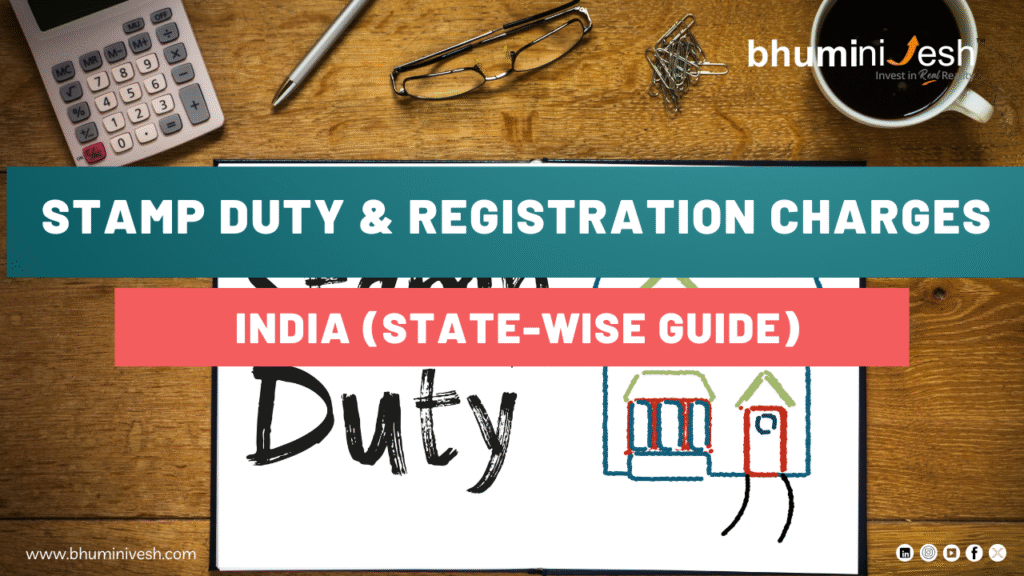
Buying a property is one of the most significant investments in an individual’s life. However, beyond the property price, buyers must also factor in government levies like stamp duty and registration charges—essential legal costs that complete the property ownership transfer. These charges vary widely across Indian states, making it essential for homebuyers to understand the applicable rates in their region.
This blog provides a detailed state-wise guide on stamp duty and registration charges in India as of 2025, including factors that influence these costs and tips to save.
What is Stamp Duty?
Stamp duty is a tax levied by the state government on the transfer of ownership of property. It is calculated as a percentage of the property’s market value or agreement value, whichever is higher. Paying stamp duty legalizes the property transaction and makes it admissible in court.
What are Registration Charges?
Registration charges are the fees paid to register the property with the government under the Registration Act of 1908. This process involves legally recording the sale deed in the registrar’s office to establish the buyer’s ownership.

Key Factors Affecting Stamp Duty & Registration Charges
Location (State/City)
Type of Property (Residential or Commercial)
Gender of Buyer (Women often receive concessions)
Type of Ownership (Joint/Individual)
Usage (Self-use or Rental/Investment)
State-Wise Stamp Duty and Registration Charges (2025)
| State/UT | Stamp Duty | Registration Charges | Women Concession |
|---|---|---|---|
| Maharashtra | 5% (urban), 6% (with metro cess) | 1% | 1% concession |
| Delhi | 6% (men), 4% (women) | 1% | Yes |
| Karnataka | 5% | 1% | No |
| Tamil Nadu | 7% | 1% | No |
| Uttar Pradesh | 7% | 1% | Rebate up to ₹10,000 |
| Gujarat | 4.9% | 1% | Yes |
| West Bengal | 5%-6% (urban), 4%-5% (rural) | 1% | Yes |
| Rajasthan | 5% (men), 4% (women) | 1% | Yes |
| Haryana (Urban) | 6% (men), 4% (women) | 1% | Yes |
| Punjab | 7% | 1% | Yes |
| Telangana | 7.5% | 0.5%-1% | No |
| Andhra Pradesh | 5% | 1% | No |
| Bihar | 6% | 2% | Yes |
| Madhya Pradesh | 7.5% | 1% | Yes |
| Kerala | 8% | 2% | No |
| Odisha | 5% | 2% | No |
Note: Rates are subject to change based on state policies. Always verify with the local registrar’s office or legal advisor.
How to Pay Stamp Duty and Registration Charges?
Online Payment: Available in most states via official portals.
Offline Payment: Through banks or treasury offices via challan or DD.
Franking: Applying a stamp (via bank or registrar) on the agreement.
E-Stamping: Digitally generated, legally valid stamp papers.
Can You Save on These Charges?
Yes, here are some tips:
Buy in a woman’s name – several states offer lower stamp duty for women buyers.
Choose joint ownership wisely – can help split tax liability.
Negotiate with the builder – sometimes they agree to bear part of the cost.
Invest during government concession periods – some states offer temporary reductions.
Why are These Charges Important?
Without proper stamp duty and registration, the sale deed isn’t legally valid. In case of disputes or resale, unregistered properties can lead to serious legal and financial complications.
Conclusion
Understanding stamp duty and registration charges is crucial when planning your property purchase in India. Since these charges vary across states and buyer categories, it’s always wise to consult a property lawyer or real estate expert before finalizing any deal.
Always include these expenses in your property budget to avoid surprises and ensure a smooth, legal transfer of ownership.

